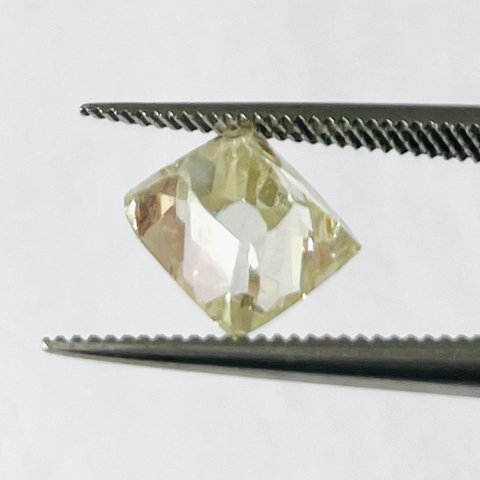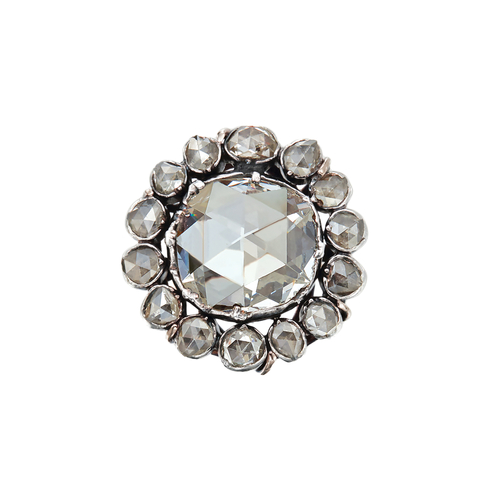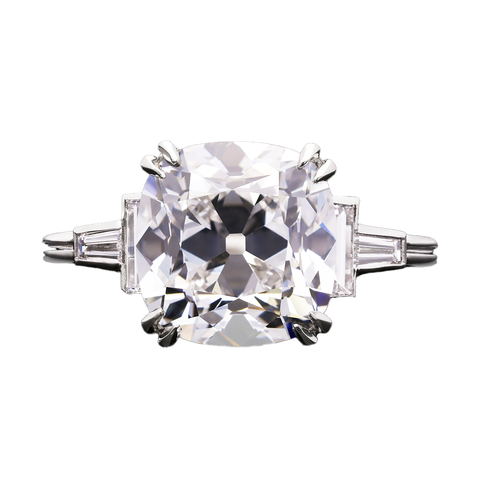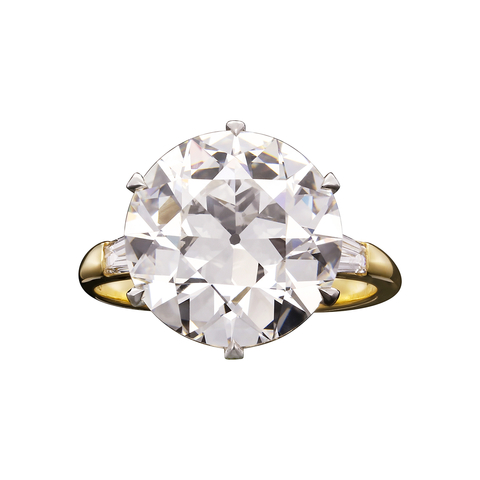A Guide to Antique Diamond Cuts

Some of the first diamonds discovered in jewelry date all the way back to the Roman era. These diamonds were used in their natural rough state, uncut and unpolished. Through hundreds of years, diamond cutting has evolved and changed as hand tools gave way to new technological innovations.
Table Cut Diamonds
The first diamonds were cut by hand and the cutter had to rely on his artistic ability and skill to cut the gems. This resulted in each diamond being slightly different with its own unique charm and personality. Eventually, the Table Cut, which is widely considered to be the first diamond cut ever developed, was introduced. This antique diamond style took a rough diamond and cut off the tip of the stone, leaving a large, flat table-like area, which is how it got its name.

Table Cut diamond
Rose Cut Diamonds
During the Renaissance period in the 1500s and 1600s some important diamond deposits were found in Brazil and India. Many of these diamonds made their way to Europe where skilled artisans began experimenting with ways to bring out the best attributes of these coveted gems.
These artistic experiments eventually led to the creation of the Rose Cut diamond. Developed in the 1500s, the cut got its name because it looks like a blossoming rose bud. A Rose Cut diamond has a dome shape, covered with triangular facets and a flat bottom. Rose Cut diamonds have a lovely shimmering sparkle and a romantic, dreamy feeling.

Rose cut diamond ring, set in silver topped gold, formerly the property of Emperor Maximillian of Mexico, House of Hapsburg, 1763
Old Mine Cut Diamonds
The next cut to make a big impact in the diamond world was the Old Mine Cut, which first came on the scene in the 1700s. These diamond cuts follow the octahedral shape of the rough stone. Because each rough diamond is slightly different in form, Old Mine Cut diamonds can be found in round, square, cushion or rectangular shapes. They have 58 facets and are distinguished by a high crown – the top half of the diamond; small table, which is the large facet on top of the diamond and an open culet (the point at the bottom of the stone).
When we look at a modern diamond, we are used to seeing the culet come to a point at the bottom of the stone. In an Old Mine Cut, there is no point at the bottom, instead there is a flat, open area. Since they were cut by hand, Old Mine diamond facet sizes and shapes will vary not only between stones, but also on the same stone itself. Not to be confused with shape, cut is the arrangement of facets on a stone, while shape is its geometric form. Cut is very important to the appearance of a diamond as the way facets are placed on a diamond impacts how much it will sparkle.
Many Old Mine Cut diamonds were created before the advent of electricity. These diamonds were cut to be seen in candlelight and they are at their sparkling best when they are seen in that type of light, which is why they are sometimes called “candlelight diamonds”. During the Georgian and Victorian eras, Old Mine Cut diamonds were at the height of their popularity.

Old Mine cut diamond
Old European Cut Diamonds
During the late 1800’s there was a new development in diamond faceting that led to the Old European Cut. Despite the name Old European, the cut was actually created in the United States by business partners Henry Morse and Charles Field who established the first diamond cutting factory in the country in Boston.
The duo took cut parameters in a new direction focusing on smaller culets, better symmetry and smaller tables. This diamond cut became known as the Old European Cut, because the diamonds were cut by people who came from Europe. It was much rounder in shape than its predecessor the Old Mine Cut. Although it is still open, the Old European cut also has a much smaller culet than the Old Mine. Widely considered to be the precursor to the modern-day brilliant cut, the Old European Cut was popular in the first half of the 1900s.
As technology advanced and diamond cutting became more precise, diamonds began to have crisper facets and more defined lines and shapes. Yet despite these perfectly cut modern stones, antique and vintage cut diamonds continue to capture the hearts and imagination of jewelry connoisseurs everywhere who love the handmade artisan feeling of these special treasures.

Old European cut diamond
Source: by Amber Michelle for Jewelers Circle. Featured image (top of page): Rose cut diamonds and silver earrings, closed back, Iberian, circa late 1700s.